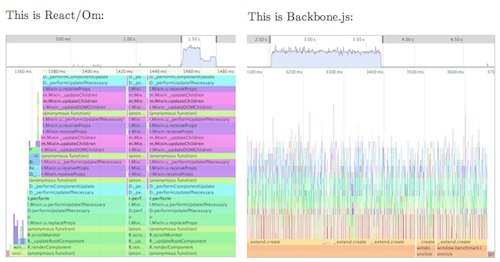Interest in React seems to have surged ever since David Nolen (@swannodette)'s introduction of Om in his post "The Future of Javascript MVC Frameworks".
In this React Community Round-up, we are taking a closer look at React from a functional programming perspective.
"React: Another Level of Indirection" #
To start things off, Eric Normand (@ericnormand) of LispCast makes the case for React from a general functional programming standpoint and explains how React's "Virtual DOM provides the last piece of the Web Frontend Puzzle for ClojureScript".
The Virtual DOM is an indirection mechanism that solves the difficult problem of DOM programming: how to deal with incremental changes to a stateful tree structure. By abstracting away the statefulness, the Virtual DOM turns the real DOM into an immediate mode GUI, which is perfect for functional programming.
Reagent: Minimalistic React for ClojureScript #
Dan Holmsand (@holmsand) created Reagent, a simplistic ClojureScript API to React.
It allows you to define efficient React components using nothing but plain ClojureScript functions and data, that describe your UI using a Hiccup-like syntax.
The goal of Reagent is to make it possible to define arbitrarily complex UIs using just a couple of basic concepts, and to be fast enough by default that you rarely have to care about performance.
Functional DOM programming #
React's one-way data-binding naturally lends itself to a functional programming approach. Facebook's Pete Hunt (@floydophone) explores how one would go about writing web apps in a functional manner. Spoiler alert:
This is React. It’s not about templates, or data binding, or DOM manipulation. It’s about using functional programming with a virtual DOM representation to build ambitious, high-performance apps with JavaScript.
Pete also explains this in detail at his #MeteorDevShop talk (about 30 Minutes):
Kioo: Separating markup and logic #
Creighton Kirkendall created Kioo, which adds Enlive-style templating to React. HTML templates are separated from the application logic. Kioo comes with separate examples for both Om and Reagent.
A basic example from github:
<!DOCTYPE html>
<html lang="en">
<body>
<header>
<h1>Header placeholder</h1>
<ul id="navigation">
<li class="nav-item"><a href="#">Placeholder</a></li>
</ul>
</header>
<div class="content">place holder</div>
</body>
</html>
...
(defn my-nav-item [[caption func]]
(kioo/component "main.html" [:.nav-item]
{[:a] (do-> (content caption)
(set-attr :onClick func))}))
(defn my-header [heading nav-elms]
(kioo/component "main.html" [:header]
{[:h1] (content heading)
[:ul] (content (map my-nav-item nav-elms))}))
(defn my-page [data]
(kioo/component "main.html"
{[:header] (substitute (my-header (:heading data)
(:navigation data)))
[:.content] (content (:content data))}))
(def app-state (atom {:heading "main"
:content "Hello World"
:navigation [["home" #(js/alert %)]
["next" #(js/alert %)]]}))
(om/root app-state my-page (.-body js/document))
Om #
In an interview with David Nolen, Tom Coupland (@tcoupland) of InfoQ provides a nice summary of recent developments around Om ("Om: Enhancing Facebook's React with Immutability").
David [Nolen]: I think people are starting to see the limitations of just JavaScript and jQuery and even more structured solutions like Backbone, Angular, Ember, etc. React is a fresh approach to the DOM problem that seems obvious in hindsight.
A slice of React, ClojureScript and Om #
Fredrik Dyrkell (@lexicallyscoped) rewrote part of the React tutorial in both ClojureScript and Om, along with short, helpful explanations.
React has sparked a lot of interest in the Clojure community lately [...]. At the very core, React lets you build up your DOM representation in a functional fashion by composing pure functions and you have a simple building block for everything: React components.
In a separate post, Dyrkell breaks down how to build a binary clock component in Om.
Time Travel: Implementing undo in Om #
David Nolen shows how to leverage immutable data structures to add global undo functionality to an app – using just 13 lines of ClojureScript.
A Step-by-Step Om Walkthrough #
Josh Lehman took the time to create an extensive step-by-step walkthrough of the React tutorial in Om. The well-documented source is on github.
Omkara #
brendanyounger created omkara, a starting point for ClojureScript web apps based on Om/React. It aims to take advantage of server-side rendering and comes with a few tips on getting started with Om/React projects.
Om Experience Report #
Adam Solove (@asolove) dives a little deeper into Om, React and ClojureScript. He shares some helpful tips he gathered while building his CartoCrayon prototype.
Not-so-random Tweet #
[@swannodette](https://twitter.com/swannodette) No thank you! It's honestly a bit weird because Om is exactly what I didn't know I wanted for doing functional UI work.
— Adam Solove (@asolove) January 6, 2014





